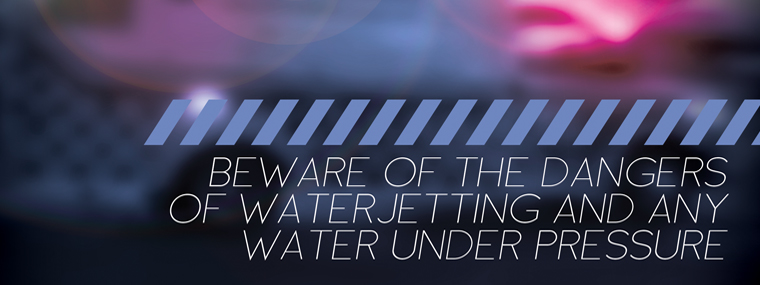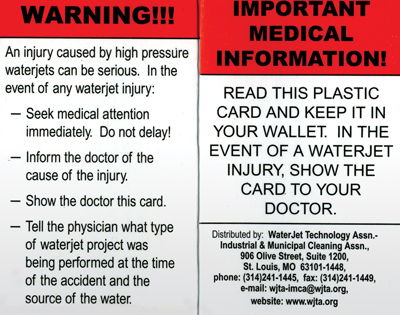
Safety: The Safety Series, Part Three: The Perils of Water at High PSI: Beware of the Dangers of Waterjetting and Any Water Under Pressure
By Terri Perrin / Published June 2015

Whether it comes from a tap, flows down a river, or falls from the sky as rain, snow, sleet, or hail, water is essential for the survival of all living species. Water is also crucial to the power washing and waterjetting industries. It is, in fact, the very core of what these industries were built on. Sure, we’ve expanded our services to include such things as soda blasting, dry ice, and other new technologies, but at the end of the day, we are nothing without water.
It is amazing to think that ordinary water, when put under pressure, can cut like a knife and cause extensive damage to both people and property. To pounds-per-square-inch (PSI), we add chemicals, extreme hot or cold temperatures, and flying debris, which turns the water wand into a potentially deadly weapon. Of all aspects of safety in this industry, few things trump the potential perils of water projected at high PSI.
Peter Wright, Manager of the WaterJet Technology Association–Industrial and Municipal Cleaning Association (WJTA-IMCA) explains that high PSI safety is something that the organization takes very seriously. “WJTA-IMCA publishes manuals and a video of recommended practices for the safe use of this type of equipment,” explains Wright. “These guidelines are used in many countries worldwide. It is important to note that these resources are available to anyone, not just association members.”
Wright stresses that equipment maintenance is a big part of injury prevention. Ensuring that all hoses, attachments, and equipment are properly configured and in optimum working order is essential to injury prevention.
“Be sure to follow WJTA-IMCA’s recommended practices and the manufacturer’s instructions on all equipment,” adds Wright. “Follow correct pre-job procedures, such as checking all connections and components before you power up a pressure washing or waterjetting engine. Be certain that the system is not under pressure before making any repair or adjustment, apart from the normal adjusting of valves and other components as required in a standard washing or jetting procedure. As importantly, proper operational procedures are essential, such as job site communication. Don’t sneak up on someone who is operating a water wand, and watch to ensure that others also don’t interfere.”
Code Red, Orange, and Blue
One way that WJTA-IMCA has addressed high PSI injury prevention is with the introduction of a color-coding scheme. It was added to the Recommended Practices for the Use of High Pressure Waterjetting Equipment in September 2011, with an implementation date of January 1, 2013.
“Hoses and nozzles are designed for specific water pressures and can present a safety hazard if not used accordingly,” explains Wright. “If a hose is rated for 10,000 PSI, for example, it should never be operated at a higher pressure.
“In order to better identify the pressure in use, we introduced a simple color code system that can be used to help identify the maximum operating pressure,” informs Wright. “The color should be easily identifiable at least two feet from both ends of the hose or the entire hose can be a different color. Some manufacturers and contractors are even going further, and color-coding spray guns and components. We don’t specify a specific RGB or hex color, like some ANSI standards do, we just ask for general colors. The table (below) is not the exact colors and is for illustrative purposes only.”
Swift Action Needed in Case of Emergency
While waterjetting and power washing injuries are rare, accidents do happen. When they occur, you will need to call ‘9-1-1.’ This is an emergency! The U.S.A. Centers for Disease Control and Prevention (CDC) has High Pressure Water Injection Management listed on its website. The organization states: “The seriousness of high pressure injection injuries is generally underestimated. The wounds often appear benign, but these injuries can result in serious infection, disability, and amputation if not treated appropriately. The potential for serious injury should be considered with any device that produces greater than 100 pounds-per-square inch (PSI) of pressure. Immediate recognition of the injury is crucial to successful management.”
 While the surface wound may not look too bad, the victim will be in considerable pain, and there could be significant damage under the skin’s surface. Air, dirty water, detergents, and debris could be deeply lodged in muscles and flesh. If not properly treated, severe infection, irreparable damage, and loss of limb, even death from complications, could result.
While the surface wound may not look too bad, the victim will be in considerable pain, and there could be significant damage under the skin’s surface. Air, dirty water, detergents, and debris could be deeply lodged in muscles and flesh. If not properly treated, severe infection, irreparable damage, and loss of limb, even death from complications, could result.
Because of the rarity of high PSI injuries, it is quite possible that emergency room personnel and first responders may have little to no experience with this type of injury. To ensure that people receive appropriate first aid, diagnosis, and treatment, WJTA-IMCA has created a double-sided, wallet sized information card that lists important information about this type of injury. Everyone working in this industry should carry this card when on the job, and be able to present it to first responders and an emergency room medical team. Have them in vehicle glove boxes, tool bins, and first aid kits. Be sure that everyone knows where the cards are and how important this information is.
The following detailed—and kind of scary—emergency treatment information is listed on the flip side of the WJTA-IMCA’s emergency wallet card. It puts the potential severity of high PSI injuries into perspective. While they may cost as little as 30-cents each for members and 50-cents each for non-members, these wallet cards are invaluable. Thirty cents is a small price to pay to ensure that an individual will receive appropriate medical care in the event of a water PSI-related accident.
Medical Alert Notes for Physicians
• This patient may be suffering from a waterjet injury.
• Evaluation and management should parallel that of a gunshot injury.
• The external manifestations of the injury cannot be used to predict the extent of internal damage.
• Initial management should include stabilization and a thorough neurovascular examination.
• X-rays can be used to access subcutaneous air and foreign bodies distant from the site of injury.
• Injuries to the extremities can involve extensive nerve, muscle, and vessel damage, as well as cause a distal compartment syndrome.
• Injuries to the torso can involve internal organ damage.
• Surgical consultation should be obtained.
• Aggressive irrigation and debridement are recommended.
• Surgical decompression and exploration may also be necessary.
• Angiographic studies are recommended pre-operatively if an arterial injury is suspected.
• Bandages with a hygroscopic solution (MgSO4) and hyperbaric oxygen treatment have been used as adjunctive therapy to decrease pain, edema, and subcutaneous emphysema.
• Unusual infections with uncommon organisms in immunocompetent patients have been seen; the source of the water is important in deciding on initial, empiric antibiotic treatment, and broad-spectrum intravenous antibiotics should be administered.
• Cultures should be obtained.
Sharing Experiences for Safety’s Sake
No one likes to admit that they made an error in judgment that resulted in someone (or themselves) getting hurt, but we all know that we can learn from our mistakes. Information sharing is an essential part of injury avoidance.
“As a means of continuing education and accident prevention, we ask that people in this industry consider sharing high PSI incidents, accidents, and near misses with the WJTA-IMCA office,” concludes Wright. “We publish these reports periodically in our Jet News, with names, companies, and any identifying information kept confidential. We have introduced an anonymous reporting tool on our website. E-mail the WJTA-IMCA office at wjta-imca@wjta.org for more information or check the Safety Topics menu item under the Resources section at www.wjta.org/wjta/Safety_Reports.asp.”




